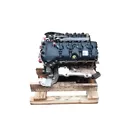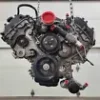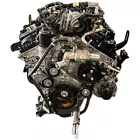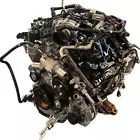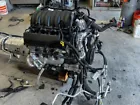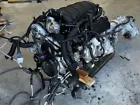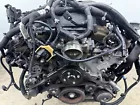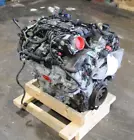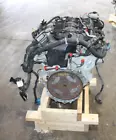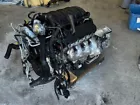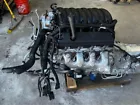Ford Mustang 5.0L Engine
3,550 $ Original price was: 3,550 $.3,000 $Current price is: 3,000 $.
Ford Mustang 5.0L Engine : An In-Depth Guide
The Ford Mustang 5.0L Engine has long been America’s best-selling pickup truck, thanks to its blend of durability, capability, and performance. A key player in the F-150’s success is its 5.0-liter V8 engine, also known as the “Coyote” engine in recent years. This engine offers a balance of power, efficiency, and reliability that appeals to truck enthusiasts, commercial users, and everyday drivers alike. Let’s dive deep into the Ford 5.0L engine—its design, evolution, specs, strengths, and how to get the most out of it.
Ford Mustang 5.0L Engine : An In-Depth Guide
The Ford Mustang 5.0L Engine has long been America’s best-selling pickup truck, thanks to its blend of durability, capability, and performance. A key player in the F-150’s success is its 5.0-liter V8 engine, also known as the “Coyote” engine in recent years. This engine offers a balance of power, efficiency, and reliability that appeals to truck enthusiasts, commercial users, and everyday drivers alike. Let’s dive deep into the Ford 5.0L engine—its design, evolution, specs, strengths, and how to get the most out of it.
History and Evolution of the Ford Mustang 5.0L Engine
The Ford Mustang 5.0L Engine badge has been part of Ford lore for decades. The original Ford Mustang 5.0L Engine came out in the 1980s and became an icon with the Mustang GT and various F-Series trucks. However, the current iteration of the 5.0L in the F-150 is the modern Coyote engine, introduced in 2011.
The Early 5.0L (1980s-1990s)
The early Ford Mustang 5.0L Engine were pushrod V8s, known for simplicity and torque but lacked modern technology like overhead cams or advanced fuel injection. These engines powered trucks and muscle cars alike but didn’t offer the refinement and power of later generations.
The Coyote 5.0L (2011-Present)
The modern Ford Mustang 5.0L Engine is a 32-valve SOHC V8 with dual independent variable camshaft timing (Ti-VCT), direct fuel injection in newer models, and an aluminum block and heads to reduce weight. It made its debut in the 2011 Mustang GT, delivering around 412 horsepower and 390 lb-ft of torque, setting a new standard for naturally aspirated V8s.
The F-150 adopted the Coyote engine in the 2011 model year and has used it consistently through the latest generations, tweaking power output and efficiency each year.
Technical Specifications of the Ford Mustang 5.0L Engine
Here are the key specs of the current generation 5.0L Coyote engine used in the Ford F-150 (model years 2011–2024):
| Specification | Details |
|---|---|
| Engine Type | 5.0L V8, naturally aspirated |
| Configuration | SOHC (Single Overhead Camshaft) with 4 valves per cylinder (32 valves total) |
| Displacement | 5.0 liters (302 cubic inches) |
| Bore x Stroke | 92.2 mm x 92.7 mm (3.63 in x 3.65 in) |
| Compression Ratio | 11.0:1 (varies slightly by year) |
| Fuel System | Port fuel injection (early models), direct injection added from 2018 onwards |
| Variable Valve Timing | Dual independent Variable Cam Timing (Ti-VCT) |
| Horsepower | ~395 to 400 hp (varies by model year and tune) |
| Torque | Around 400 lb-ft |
| Engine Block Material | Aluminum alloy (lightweight and strong) |
| Cylinder Heads | Aluminum |
| Cooling System | Water-cooled |
| Emissions | Meets modern EPA Tier 3 standards |
Performance and Capability
The Ford Mustang 5.0L Engine is celebrated for its combination of raw power and refinement. It’s powerful enough for towing heavy loads yet responsive and smooth for everyday driving.
-
Horsepower & Torque: With up to 400 hp and 400 lb-ft of torque, it can tow trailers upwards of 11,000 lbs (depending on configuration).
-
Fuel Economy: While a V8 isn’t known for great fuel economy, the Ford Mustang 5.0L Engine with Ti-VCT and direct injection achieves competitive fuel mileage for a truck of its size, typically in the low 20s mpg on the highway.
-
Towing & Hauling: The engine’s strong low-end torque is crucial for towing, making it a popular choice for truck buyers who haul trailers, boats, or heavy loads.
-
Drive Experience: Compared to older pushrod V8s, the Coyote runs smoother, revs higher, and delivers power more linearly, thanks to its DOHC design and variable cam timing.
Design Highlights
Aluminum Construction
The use of aluminum for the block and heads keeps weight down, improving handling and fuel economy without sacrificing strength.
Ti-VCT (Twin Independent Variable Camshaft Timing)
This system adjusts valve timing on both the intake and exhaust camshafts independently to optimize performance and efficiency across different RPM ranges.
Direct Injection (DI)
Introduced in 2018, direct injection sprays fuel directly into the combustion chamber, enhancing power, efficiency, and emissions control.
Active Cylinder Technology (ACT)
On some models, Ford added cylinder deactivation technology to shut down four cylinders during light-load conditions to save fuel.
Common Applications and Trims with Ford Mustang 5.0L Engine
The Ford Mustang 5.0L Engine is offered across many F-150 trims, from the well-equipped XLT and Lariat to the luxury-oriented King Ranch and Platinum trims. The engine balances performance and luxury well.
It is also used in some sportier F-150 variants and specialty trims, including:
-
F-150 Raptor (though the Raptor mostly uses the 3.5L EcoBoost V6, some enthusiasts swap in the 5.0L)
-
F-150 Tremor (special off-road trim)
-
Aftermarket swaps and custom builds
Maintenance and Reliability
The Ford Mustang 5.0L Engine is known for its reliability but does require regular maintenance like any modern engine:
-
Oil Changes: Recommended every 7,500 to 10,000 miles with synthetic oil.
-
Spark Plugs: Typically replaced every 100,000 miles.
-
Timing Chain: The Coyote uses timing chains, which are more durable than belts but still require inspection.
-
Cooling System: Keep the radiator and cooling system maintained to avoid overheating, especially when towing.
-
Fuel System: Direct injection systems benefit from occasional fuel system cleaning to prevent carbon buildup.
Many owners report the Ford Mustang 5.0L Engine running trouble-free beyond 200,000 miles with routine maintenance.
Common Issues and How to Avoid Them
While generally robust, some issues to watch for include:
-
Carbon Buildup: Direct injection engines can suffer from carbon buildup on intake valves. Periodic intake cleaning can help.
-
Valve Train Noise: Early models occasionally had cam phaser noise, which was improved in later revisions.
-
Oil Leaks: Some minor oil leaks from gaskets or seals have been reported, manageable with regular inspections.
-
Spark Plug Wear: Long-life plugs should be inspected periodically for fouling.
Aftermarket Upgrades and Tuning
The Ford Mustang 5.0L Engine has a huge aftermarket following, especially among enthusiasts wanting more power or a customized sound.
Common Upgrades:
-
Cold Air Intakes: Increase airflow for better performance.
-
Performance Exhausts: Improve engine breathing and give a deeper, more aggressive sound.
-
Superchargers/Turbochargers: Forced induction kits are popular for big power gains; a supercharged 5.0L can easily push 600+ hp.
-
ECU Tuning: Reprogramming the engine computer unlocks more horsepower, torque, and improved throttle response.
-
Camshaft Upgrades: High-performance cams can increase top-end power.
-
Headers: Improve exhaust flow, reducing backpressure.
With these mods, it’s common to see F-150s with Ford Mustang 5.0L Engine making 450-700 horsepower in modified form.
Summary
TheFord Mustang 5.0L Enginee is a hallmark of American V8 performance, blending modern technology with classic power and reliability. From its aluminum block and heads to its sophisticated variable valve timing and direct injection, the 5.0L Coyote engine remains a top choice for those needing a strong, capable, and durable V8 in their truck.
Whether you use your F-150 for daily driving, heavy towing, or weekend fun, the 5.0L V8 offers the balance of performance and practicality that has helped make the F-150 an all-time best-seller. And for enthusiasts, the engine’s robust aftermarket support means you can tailor its power to fit almost any need or taste.
If you want, I can also provide information on:
-
Step-by-step maintenance schedules for the 5.0L
-
Comparison with other engines in the F-150 lineup
-
Specific performance upgrade guides
-
Common troubleshooting and diagnostics tips
Would you like me to go deeper into any of those areas?
Related products
Engine
Engine
Engine
Engine
Engine





